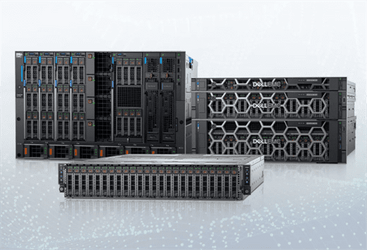Dell 15th Gen server updates
11th Oct 2022
Dell's latest server generation offers a number of significant upgrades across the product line. These updates include more support for GPUs than ever before; better cooling designs for more efficient and environmentally sustainable operation and new processor support on both the Intel and AMD platforms. Here are a few highlights.
The Intel side for this generation introduces the use of Intel 3rd generation scalable Xeon processors for the first time to Dell systems. This introduces a number of advantages over the previous 1st and 2nd generation scalable Xeon processors such as.
- IPC improvements over the previous generation processors leading to more processing power at the same clock speeds.
- Increase from six memory channels to eight memory channels. This along with new memory prefetch techniques and other efficiency improvements improves memory bandwidth upwards of 100%.
- Increase of DRAM capacity per CPU improved from 1TB per CPU to 4TB per CPU in the higher end servers such as R750.
- Introduction of PCI-E Gen 4 offering far higher bandwidth on PCI-E cards supporting PCI-E Gen 4 vs older Gen 3 cards.
On the AMD side of the 15th generation server range Dell utilizes 2nd and 3rd generation EPYC processors. These processors introduce a number of improvements as well.
- 64 core / 128 thread processors are the highest thread count processors you can utilize in Dell’s server catalog.
- 4TB of memory addressable per CPU meaning extremely high amounts of memory can be populated in these servers.
- general performance increase in IPC leading to up to 19% performance increase at same clock speeds.
Introduction of new cooling designs allow for higher performance systems when required.
- Dell Direct Liquid Cooling (DLC) is a new option that allows for liquid cooling deployments in extremely high performance systems. This allows for much better cooling performance in systems that are running extremely powerful processors. Utilizing liquid cooling allows for clock speeds to stay closer to their max speeds for longer periods leading to improved performance.
- Along with DLC, Dell has implemented Dell Leak Sense which is managed by the iDRAC. This allows for the system to detect if any leaks occur in the chassis and can auto power down the system and alert if there are any detected leaks to help protect the system in the case of a liquid leak.
More support for GPUs than any generation before along with first ever Nvlink support from Dell in the XE8545 server which is specifically targeted at GPU accelerated workloads. Broader support for mixed PSU modes potentially allowing for higher power loads depending on the specifications of the server. There are now four ranges that Dell positions its servers in.
- Essential: Entry level technology for small to medium businesses and remote office / branch office deployments.
Specific workload examples: General IT infrastructure.
Servers: R550, R450, T350, T150 - Scalable: Performance Technology that balances capability and capacity with enterprise features.
Specific workload examples: VDI, Cloud Applications, Software-defined-storage(SDS)
Servers: R750xs, R650xs, R7515, R6515 - Mainstream: Latest Technology designed for best-in-class performance.
Specific workload examples: Virtualization, Big data analytics, SDS, Data Center Infrastructure
Servers: R750, R650, R7525, R6525, MX750c - Specialized: Latest technology focused on specialized compute needs.
Specific workload examples: HPC, AI/ML, Object storage, Cloud storage, Databases, Edge computing, Web tech.
Servers: XE8545, XR11, XR12, R750xa, C6525, C6520.

